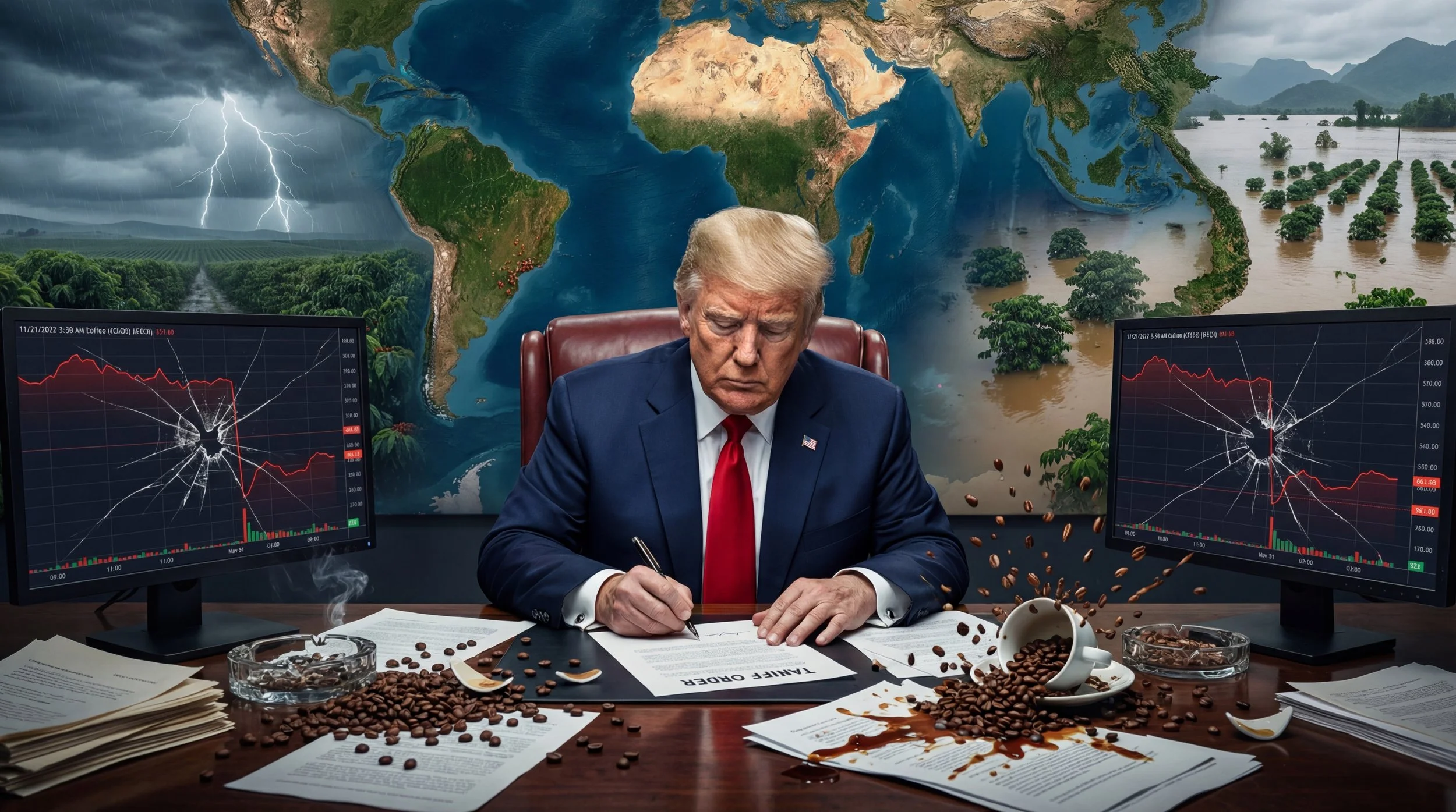Simultaneous Shock in Arabica and Robusta – Who Shook the World’s Coffee Cup?
On 21 November 2025, coffee traders opened their screens to see two charts collapsing at the same time:
March Arabica (KCH26) slipped from around 375 c/lb down to ~358 c/lb, then clawed back to the 361–362 c/lb area.
January Robusta (RMF26) fell from about 4,650 USD/ton into the 4,430–4,450 USD/ton zone.
Both contracts finished the day roughly 4% lower – a dramatic move in a normally heavy, institutional market.
The obvious question is: how can coffee futures crash on the same day that floods are drowning large parts of Vietnam’s coffee belt? The answer sits at the intersection of weather, politics and macro economics.
The Economic Drivers: Brazil’s Rain vs. Vietnam’s Floods
Brazil – Rain That Reads as “Future Oversupply”
For two days, reports on Barchart and Nasdaq have repeated the same message:
“Heavy rain forecasts across Brazil’s key coffee regions are hammering prices.”
Weather service Climatempo is calling for significant rainfall over the Brazilian Arabica belt – especially Minas Gerais – into late November and early December. After a dry spell, this is exactly what coffee trees need for flowering and cherry formation.
For futures traders the translation is simple:
“If the next two crops in Brazil are strong, today’s elevated prices are too expensive.”
Vietnam – Floods, Frozen Harvest and a Price Disconnect
On the other side of the world, Vietnam – the capital of Robusta – is literally under water:
Some regions have taken over 1,500 mm of rain in a few days.
At least dozens of people have been killed or are missing.
More than 10,000 hectares of farmland, including coffee plantations, are flooded.
Power cuts hit hundreds of thousands of homes and the harvest in Dak Lak is almost frozen, with only 10–15% picked so far.
At the same time, local sources report reco
Why this disconnect? Because the futures market is not just pricing today’s floods, it’s also pricing the official crop numbers that still project around 6% year-on-year production growth in 2025/26 to about 1.76 million tons. On paper, supply next year remains strong.
ICE Stocks – Tight Today, Potentially Heavy Tomorrow
Another key ingredient is the level of ICE-certified warehouse stocks:
Arabica stocks in New York have fallen to around 19-month lows.
Robusta stocks in Europe are near multi-month lows as well.
This means the physical market is tight today, but traders also see that if Brazilian rains and Vietnamese production forecasts prove correct, the world may be facing a supply wave 12–18 months from now.
This mismatch in time horizons makes volatility explode. Short-term news becomes an excuse to aggressively adjust large positions that are built on long-term expectations.
Politics: Pouring Fuel on the Coffee Fire
1. US Tariffs on Brazilian Coffee – and a Sudden Reversal
A few months ago, the US imposed punishing tariffs of up to 40% on Brazilian food imports, including coffee, as part of political tensions around former president Bolsonaro.
On 20 November 2025, just one day before this crash, a new executive order was signed in Washington: according to Reuters and other outlets, a large part of those tariffs on Brazilian coffee and meat will be cut or removed to ease pressure on US consumers ahead of the holiday season.
For the market, the logic is straightforward:
If importing Brazilian coffee into the US becomes cheaper and easier again,
and Brazilian weather simultaneously points to a strong crop ahead,
then the fear of a structural Arabica shortage in New York suddenly looks exaggerated. That mood change showed up instantly as a vertical red candle on the KCH26 chart.
MRGT Base Case: A Violent Sideways Market for the Next 15 Days
Using intraday data from Barchart on 21 November:
KCH26 (March Arabica) is trading around 361–362 c/lb.
RMF26 (January Robusta) sits near 4,440–4,450 USD/ton.
What follows is analysis from MRGT for educational purposes only – not trading advice.
Our highest-probability scenario: a “whipsaw range”, not a straight crash
Assumptions:
Brazilian rains continue roughly as forecast, without new extreme surprises.
Vietnamese floods gradually ease over the next days; damage is meaningful but not catastrophic at national level.
No fresh, major political shock beyond the tariff adjustment already announced.
Under these conditions, our base case for the next 15 trading days is:
KCH26 chops in a broad band between 350 and 375 c/lb.
Dips into the low 350s attract buying from origins and roasters.
Spikes back toward 375–380 c/lb meet selling from funds and hedgers.
RMF26 oscillates roughly between 4,300 and 4,600 USD/ton.
Breaks below ~4,300 USD/ton are possible but likely short-lived without a perfect Brazil+Vietnam combo.
Moves back above ~4,600 USD/ton need fresh bullish shocks (new flood damage, new political risk), which we do not treat as the most likely outcome in this short window.
MRGT coffee desk, we see:
A market that has just burned off its weather-and-tariff premium, and is now entering a high-volatility sideways phase, not the start of a clean, one-way bear market.


